Whenever we can, we honor and thank veterans for defending our freedoms. This Article Features James Earl Arnold, a D-Day Veteran.
Memorial Day is a federal holiday in the United States that mourns the U.S. military personnel who have fought and died while serving in the United States armed forces. It is observed on the last Monday of May at national cemeteries by placing flowers and American flags on the graves of military personnel.
In the United States, Memorial Day is set aside for mourning U.S. Military Personnel who have passed away while serving their country. Observations take place on the last Monday of May at national cemeteries. The community comes out to place flags on graves and bring flowers to memorialize their loved ones who passed.
Memorial Day
One of the best ways to honor those who have served is to remember who they were as people. Here is the story of one man, James Earl Arnold, and his family.
Every war, it seems, is thought to be the one to end all conflicts. We wish it were so. Yet, in every case, there must be those who stand up. James Earl Arnold, a veteran of two world wars, played an important role in the D-Day Assault. Many deserve our thanks, and when you have a veteran in your family, you are especially reminded and grateful.
Lloyd Draper, a retired school teacher at Niagara, Wheatfield, New York, and his family have long honored the memory of his Great Uncle, James Earl Arnold, who was assigned as the Navy Officer In Charge of the Allied invasion at Utah Beach—Normandy, France.
Over the years, the WWII U.S. Navy NOIC Helmet that Commander Arnold wore when he landed on Utah Beach on June 6, 1944, has been a treasured reminder of his service.
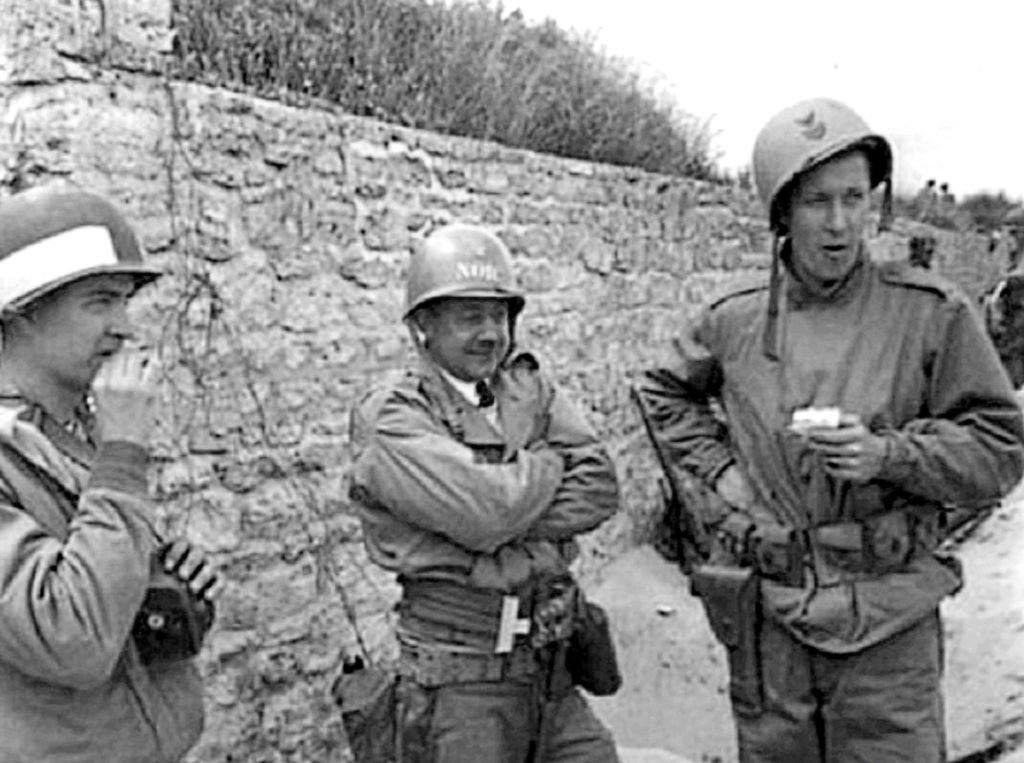
In the above photograph, Commander James Earl Arnold is shown wearing his NOIC helmet; he is standing in the middle between two friends as they take a break shortly after arriving at Utah Beach on D-Day, June 6, 1944. Although there are no notes on the original photo to say when this image was taken, an Antiques Roadshow appraiser, Jeff Shrader, determined that it was taken on D-Day since Arnold is still wearing his invasion life belt around his waist. It is thought that the man on the left was Commander Arnold’s Driver, a man by the name of Carey. Men assigned to the Naval Officers in Command (abbreviated NOIC) had white stripes on their helmets.
FEATURED ON THE ANTIQUE ROADSHOW
Around the 75th anniversary of D-Day, Lloyd Draper recalled the helmet his grandmother, Effie Arnold Draper, had given him years before when he was only fourteen years old. He had been visiting and noticed an unusual container in which to grow flowers. His grandmother told him about her brother, James Earl Arnold, who had worn this helmet when he commanded the D-Day assault at Utah Beach.
Grandmother Effie told the young Lloyd a few more family stories, but at that age, WWII and the lives it had affected were not as vivid as they would have been to others. So the stories became a distant memory and the Helmet a treasured curiosity. Lloyd remembered his grandmother’s words, “Your uncle was a very important man!” Once he looked into his history, he understood just how important his great uncle James had been.
An opportunity came to find out more via the Antiques Roadshow. Lloyd Draper was featured with his great uncle’s Helmet in the first Antiques Roadshow segment, which aired on Monday, April 25th, 2022, on PBS Buffalo Station WNED Channel 17 with appraiser Jeff Shrader. This episode was taped on the Grounds For Sculpture in Hamilton, New Jersey.
Jeff Shrader of the Antiques Roadshow examined the Helmet, saying, “In consideration of the importance of the success of the Utah Beach Landing. The fact that James Earl Arnold wore the helmet on D-Day, and because he would have been the only one wearing a helmet with the Captain’s Eagle Insignia, makes it a one-of-a-kind.” Jeff Shrader said that if the Helmet were to be entered into an auction now, a conservative estimate would be about $30,000 to $40,000.
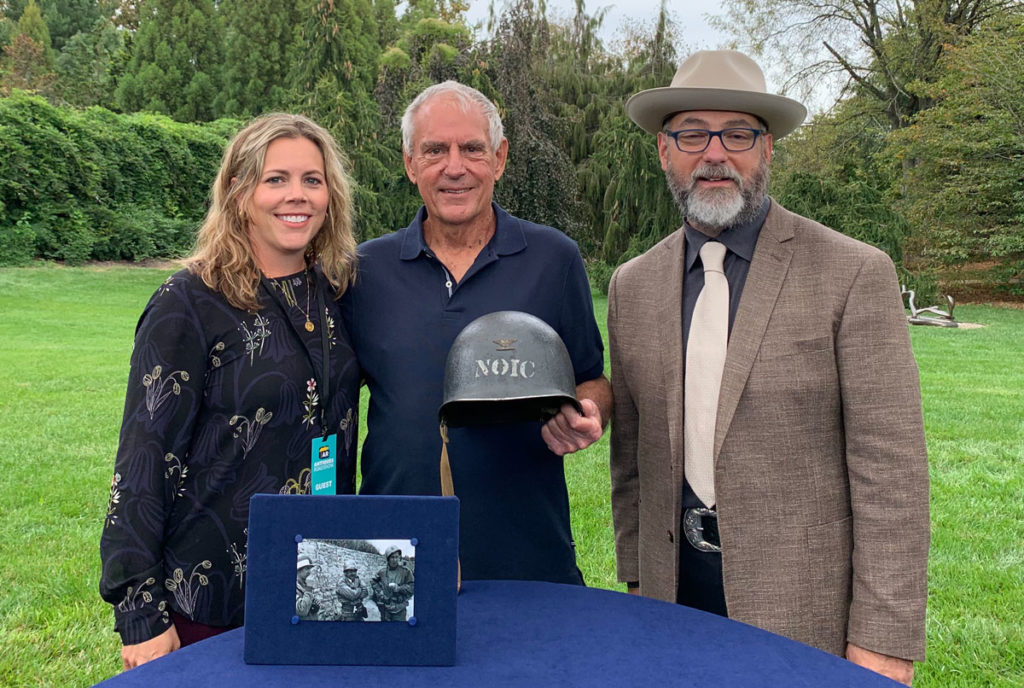


We all take courage from our family’s stories of how our ancestors influenced our lives today. It is a way to honor and remember them, pass along their knowledge to the next generation, and find kindred traits in ourselves. Why do we gravitate to specific endeavors? Is there an artist’s trait in your heritage, or possibly entrepreneurship? How many in your family joined the military? Do you have courageous men and women who stepped out in life to make our world a better place? Knowing about certain traits can give you hope and courage to forge the right path for yourself.
Celebrating A Life Well Lived
Lloyd contacted me at the recommendation of a mutual friend, Eva Nicklas, of the Lewiston Council of the Arts. I love the challenge of discovering nuances of a person’s story from more than one perspective, so I began the research process that led to this blog about James Earl Arnold and his extraordinary accomplishments.
If you have ever spoken with anyone involved in the weeks referred to as the D-Day invasion, they may not tell you how horrific their memories are. Soldiers landing on the beaches met with numerous land mines, wooden stakes, metal “Hedgehogs” meant to tear the bottoms of ships during high tide, and heavy fire. Despite the Allied secrecy ahead of the attack, German troops lined up on ridges and held the Allied Forces in their foxholes, trenches, tents, and any fortifications they could hide in for seven long weeks! It was hard to believe anyone would survive it!
The landing at Utah Beach was one of the last assaults planned to take place. Commander Arnold’s fleet was delayed due to high winds blowing ships further south than intended. On arrival, along with those under his command, Arnold ran to cover, bringing medical supplies for the many wounded already there. Commander Arnold discovered himself to be taking cover along with the American Ground Forces leaders, General Teddy Roosevelt Jr., General Raymond Barton, and one other whose name is not available at this writing. I am sure they had a lot to talk about the events taking place just then.
Harry Brewster gives this quote in an article written about James Earl Arnold and his experiences at D-Day.
“I don’t think any of the group landing with me were hit during the disembarking, but shell bursts were too damned close. We had only a couple hundred feet of beach to cross before reaching the sea wall and the fox holes dug by the beach battalions. Oh boy were those holes comfortable, when the shrapnel sang and burst!”
James Earl Arnold – Diary
Is there more to this story? In these uncertain times, we all need to look into what gives any man or woman the courage to go forward in the face of what seems to be an invincible opposing force. Is there some inspiration we can all glean from Arnold’s life? I believe there is.
A Memorable Biography
Lloyd Draper paints a picture of what he knows of his Great Uncle, James Earl Arnold. Stories of our relatives circulate by word of mouth. We love to tell the stories of our family heroes over and over again. Did they live exciting or typical lives? Everyone has some interesting or fun story about a relative. If you delve into your family’s history, you might find it reveals a mystery or two. It is how we gain an understanding of ourselves. It is fun to share their stories and learn from those who have lived in our Genealogical Family Trees. Many families have a culture of this kind of sharing. Often, years later, descendants are grateful for the stories and information. Other families have not adopted this practice, and it is sad to hear of someone wishing they knew more about their family histories than just names, birth, and death dates…
“When I think of my Great Uncle James, and just how involved he was in the whole process of the planning, practice, and execution of the (WWII) Invasion, I am in awe of his accomplishments.”
Lloyd Draper
Life and Times
James Earl Arnold was born on the 5th of May 1895 at North Troy, Orleans, Vermont, and passed away on the 4th of November 1971 at Bethesda, Montgomery, Maryland. He was buried at Arlington National Cemetery on 8th November 1971.
Arnold attended Worcester Polytechnic Institute in Worcester, Massachusetts. This is one of the United States’ first engineering and technology universities, founded in 1865. He received a degree in Mechanical Engineering in 1917. After university, he enlisted in the US Navy, where he served on battleships, destroyers, and submarines in the Pacific and North Atlantic Oceans. Upon retiring, he received the title of Lieutenant Commander.
Arnold lived in Natick, Massachusetts, for much of his civilian life. He held several positions, including sales engineer for the Boston District with the law firm Leland-Gifford Company, Worchester, Massachusetts. He also served as a member of the Massachusetts House of Representatives and worked at the Bethlehem Steel Company in Quincy, Massachusetts.
James Earl Arnold served in two World Wars.
Arnold served on the USS Fulton during the First World War on a training ship. He was in submarine service until 1924. He then served as Executive Officer of the USS Edsall and operated with Squadron 9, Destroyer Squadrons, and Scouting Fleet until June 1926. James retired after the First World War, never contemplating whether he would serve a second time.
A Call To Duty!
“Your mission is to build and maintain an advanced amphibious base at Falmouth, England, for the training of U.S. Naval Forces for a proposed assault on the European Continent. This assault accomplishes the total defeat of the German Army. Your command will include two sub-amphibious bases at Fowey and St. Mawes. Training will include all types of assault landing craft and attendant escort vessels, minesweepers, combat ships, and far shore groups. Beach battalions, demolition crews, pontoon construction gangs, Rhino Ferry crews, mine disposal squads, salvage crews, repair vessels, hard crews, fire-fighting crews, communications gangs, and hospital facilities. Your responsibility will include bivouac facilities ashore and for all shore-based personnel. Offices and communications for Flotilla and squadron staffs”.
Having been given the rank of Commodore (meaning for temporary service) in 1940, James Arnold was posted to Roseneath, Scotland, in September 1943 and shortly afterward received this mission. It was a BIG ORDER!
As Commander of the Falmouth Base, Arnold oversaw the building of the base from the ground up and the training of recruits.
In March 1944, his next orders came in. “James E. Arnold detached as COUSNAAB, Falmouth. Report Comlancrabeau, Plymouth England, in connection planning assault group for duty far shore.” He later wrote,
“I was selected to command Utah Beach and at that time I became “bigoted” which was a term identifying those who were let in on all the hush-hush stuff. I was shown into an underground secret room 200 feet underground at Hamoaze House, Plymouth, where pictures of the beaches were pasted on the walls and there was a rubber replica of the landing beaches”.
James Earl Arnold
Arnold was the last speaker during the Hamoase House strategy sessions. He was tasked with Commanding the Far Shore at Utah Beach, which was planned as the final phase of the Operations Theater before the Allies began the assault on D-Day.
A chapter from James Earl Arnold’s autobiographical writings continues with graphic descriptions of his many experiences.
“I have lived in wet clothes for days and gone without a bath for weeks. I know the helplessness of lying in a foxhole while air bombs drop and the fear of seeing men blown to bits by bursting shells. I know the experience of eating K rations out of a paper and can remember some of the days when I didn’t eat at all – and didn’t seem hungry. I have felt the urge to kill and keep killing and the horror of badly wounded men – some hopelessly hurt making little whimpering noises like a whipped little boy. And I know the feeling of loneliness for family and home, which is one of the most hopeless of all the sicknesses. But also I have seen in the last few weeks more pleasant things to remember. Good men standing by good officers. An army which has no equal in the world.”
James Earl Arnold
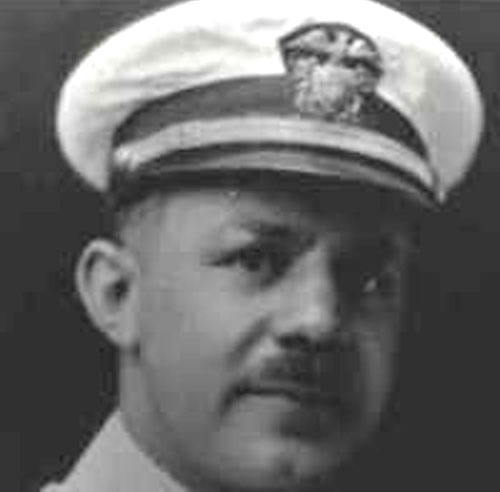

On the right above is a photograph taken at Utah Beach on the thirtieth day. From left to right: Captain James Arnold (NOIC Utah), Colonel Eugene Caffey (USA Engineers), and Commander Edward Wilson (Deputy NOIC Utah). Source: Naval History and Heritage Command, UA 02.02 RADM.
Ready for anything, Day or Night
“Awakened at 3:30 am in his tent by his jeep driver, saying that there was someone who wanted to talk with him. He walked out of the tent to meet General George Patton who had come to ask for his help in unloading his ships full of men and equipment. He later guided Winston Churchill on a tour of the beaches and met with Charles DeGaulle.“
James Earl Arnold
A List of Awards for James Earl Arnold
After the Utah beaches were cleared, Arnold was chosen to go to Le Havre to clean up and restore that harbor for shipping. He was commander of the port until the end of the war. Arnold retired for the second time on April 1, 1951, and was promoted to Rear Admiral based on his combat awards.
“In addition to the Legion of Merit with Combat V, Rear Admiral Arnold has the World War I Victory Medal; the Navy Expeditionary Medal Service Medal; the Yangtze Service Medal (USS Edsall-1926); the American Defense Service Medal; American Campaign Medal; European-African-Middle Eastern Campaign Medal with two engagement stars; World War II Victory Medal; and the Naval Reserve Medal with a star for twenty years of service. He also was awarded the Croix de Guerre with a bronze star by the Government of France “for outstanding services…in the liberation of France.”
The Memoirs of James Earl Arnold
James E. Arnold’s memoirs help the Arnold family and us all understand more about the meaning of WWII and are reminded of the bravery, service, and sacrifices made by so many.
As the Ode of Remembrance, from a poem by Laurence Binyon, so aptly puts it… “At the going down of the sun and in the morning. We will remember them!
A grandson, Jay Arnold, has kindly set up an extensive website. James Earl Arnold. A Tribute to James E. Arnold can be viewed through this link.
Purple Shirt and Ginger Snaps
The first chapter is entitled Purple Shirt & Ginger Snaps, by James E. Arnold, plus an article published in The Boston Herald, Tuesday, April 10, 1951, entitled, “Navy Cancels Arnold Debt, Purple Shirt, Ginger Snaps Returned After 30 Years” written by Bill Cunningham and later edited by Barbara W. Arnold.
This is an amusing snippet about James E. Arnold’s early life and enlistment in the Navy. His family and friends affectionately knew him as Bennie Arnold back then. It mentions the 14 farewell parties held in his honor in 11 days at the Great Lakes station.
“Back when World War I was breathing hotly on the necks of the just-post-teen-age generation, Bennie Arnold enlisted in the United States Navy as a Machinist, Second Class. Ten days ago, after more than 30 years in and out of its uniform, he was retired as a Rear Admiral, and, from all accounts, the operation he refers to as “the decommissioning of the old hulk “Bennie must have established a record in a department where the records are pretty hard to beat.”
Bill Cunningham
The article goes on to tell the story of when James E. Arnold, nicknamed Bennie, enlisted and almost missed the boat. He had on a Purple Silk Shirt and carried a box of lovingly made Ginger Snaps by his mom, Anna May Blenkhorn Arnold. Both of these treasures were tossed overboard as he entered the ship. But 30 years later, someone had a great idea at a retirement party and returned two similar items. A Purple Silk Shirt and a box of Ginger Snaps. Unfortunately, they were not made by his mom since she passed away, but I’m sure they were homemade…
The article also tells a little about James’ character, as told by a man who served under Arnold. “It needs to be understood that although James Earl Arnold is a horse for work and was a deadly serious, firm, and resourceful officer under fire, he really is something of a comedian, and life around him has its steady quota of laughs.”
Thirteen Chapters Full of Memoirs
The Memoirs are a great read. Informative, witty, and well-written, Arnold could add writer to his numerous qualifications. The very next rainy Sunday afternoon, I suggest you sit down at your computer and give the whole thing a read.
Family
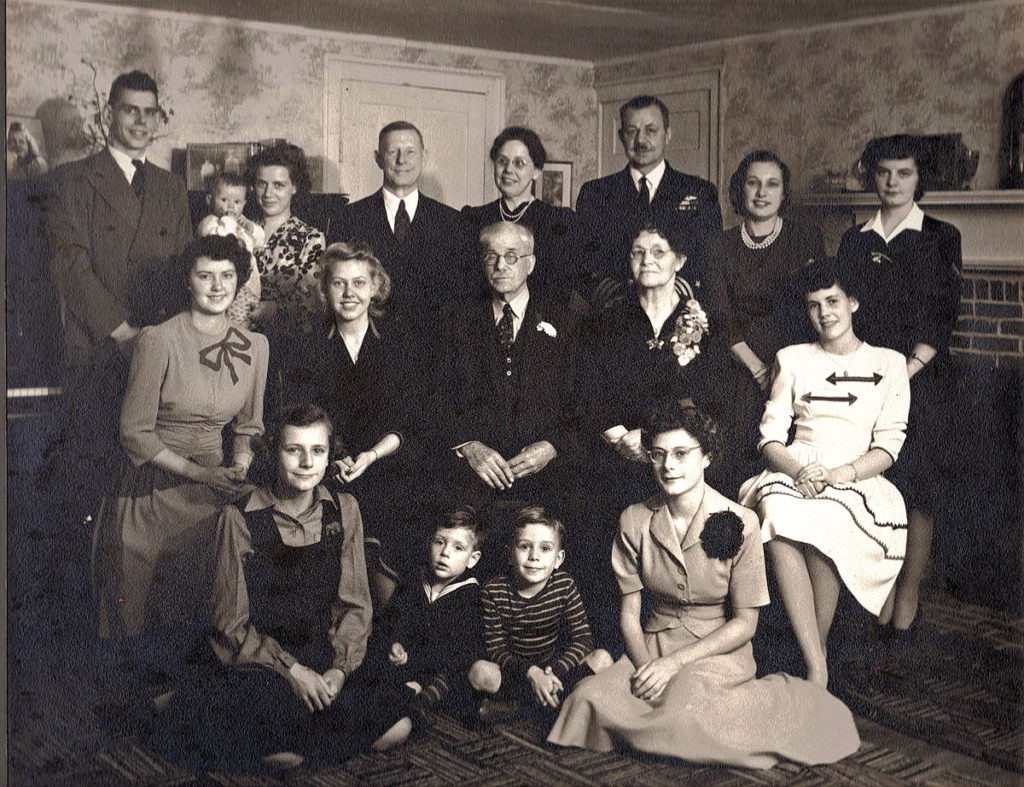
The Fiftieth Wedding Anniversary
of Cyrus Haney Arnold and Anna (Annie) May Blenkhorn Arnold
Parents of James Earl Arnold
- Front Row, L to R – Ann Arnold, Lloyd Draper, James (Jim) E. Arnold, Jr., and Margy Jane Arnold (wife of James Earl Arnold – not in the photo as he was deployed)
- Middle Row, L to R – Barbara Dorothy West Arnold, Ella Brown Draper, Cyrus Arnold, Annie Blenkhorn Arnold, and Dottie Van Iderstine.
- Back Row, L to R – Richard Draper, Loraine Draper, Erma Tallman Draper, Walter Draper, Effie Arnold Draper, James Earl Arnold, his wife, Margaret Lewis Arnold, and Hope Arnold. Hope and Barbara Arnold were daughters of James E. Arnold and his first wife, Dorothy Eveline West Arnold.
- As stated in the family Bible, Cyrus and Anna were married on November 28, 1892. The above photograph was taken on November 28, 1942.
Cyrus and Anna Arnold were married on February 18, 1893, in Nashua, Hillsborough, New Hampshire, USA.
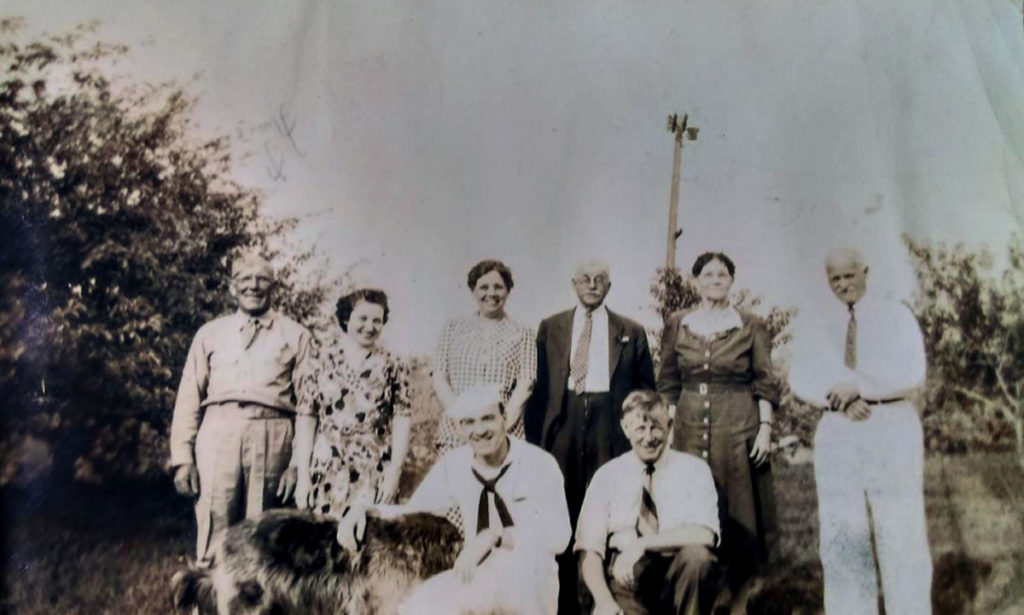
The above brief Homecoming photograph was taken on July 1st, 1944. James Earl Arnold returned to the USA in 1945 and served in the First Naval District in Boston until his retirement on April 1st, 1951. (re Obituary)
Standing Back Row L to R: James Earl Arnold and wife Margaret “Margy” Lewis Arnold; Effie Sophia Arnold Draper (JEA sister); Cyrus Haney Arnold and Anna May Blenkhorn Arnold (JEA Parents); and a Relative.
Front Row L to R: The family dog; a friend or relative; Walter Draper (Effie’s husband).
RAdm. Arnold was survived by his wife, the former Miss Margaret Lewis of San Diego, and their five children: Mrs.Barbara W. Arnold, Concord, Mass.; Mrs. Hope Arnold Barre, Albuquerque, N. M.; Mrs. Jane Cosgrove, San Diego, Calif.; Mrs. Ann Driscoll, Farmington, N. M.; and Major James E. Arnold, Jr., Colorado Springs, Colorado. Barbara and Hope Arnold were daughters of James Earl Arnold’s first wife, Dorothy Eveline West Arnold, who passed away in 1924. (re: Obituary)
A Supportive Family with Many Memories. There are more stories yet to tell, and Lloyd’s Aunt Ella Brown Draper, who turned 101 on April 24, 2022, must indeed have a few of her own to share.
Family is what keeps a soldier going!
As a soldier, it is those moments when you are cold, wet, and hungry but must endure whatever you are facing that the thought of a family memory will carry you through. You focus on that. You ignore where you are. The physical exhaustion can be overwhelming, and you wonder how you will continue. For all the bravery and witty repartee at other times, these moments try your soul.
In the long marches with your fellows, brothers at arms that you know will watch your back, you joke and carry on as if this was some play. One of the things you often ask each other is, “What is the first thing you are going to do when you get leave to go home?” Or, “I am going to have a big slice of my mom’s chocolate pie; what’re you going to eat?”
Perhaps James Earl Arnold replied, “I’m going to have a dozen of my mom’s Ginger Snaps! We can only imagine some of the memories that carried him through.
A Glimpse into the James Earl Arnold family is given when you read between the lines of a story called The Boomshack.
The Boomshack was a cottage in Maine where the James Earl Arnold family spent many summer vacations from 1962 to 1972. James’ daughter, Barbara Dorothy West Arnold, wrote a story in 1981 based on these summer vacations. She says the story is mostly true, with some names changed so that their neighbors would not recognize themselves in it if it were published.
Explaining her story, Barbara says, “It was written in loving memory of my then teen-aged daughters, a little boy, a dearly loved summer place in a small Maine town where I was ALWAYS happy… and in remembrance of a true love story that was great while it lasted.” You can read the whole story at this link.
Barbara writes about how her dad came into possession of the Boomshack. She says he was a crafty poker player. In a letter that her dad wrote asking her to check out the place later, he writes,
“I became suddenly drunk, and next morning I was in possession of a building on the Kennebec River, for which I have no recollection of having negotiated, save the stake which was five hundred bucks.”
James E. Arnold in a letter to his daughter, Barbara. This event was also briefly written about in one of his diaries.
Later in the book, Barbara describes. “He came for his breakfast. Said he’d eat last night’s leftovers… (he arrived late). You can appreciate the state of breakfast, having languished in the warming oven for two hours. The potatoes looked orange, smelled ripe, and felt crunchy. He said they were delicious! The creamed corn was dark brown, having little resemblance to anything edible whatever [sic]. He pronounced it …GOOD.”
“Boy, ain’t I hungry,” he said. “And ate a half a dozen sausages that not only looked like but had to taste like cigars.” (continuing with) “I’m hungrier’n a barstid.” [sic]–“Whatever that is! And topped it off with two slices of blueberry pie …cold. Luckily, I had not decided to heat it up like the rest of his meal. He drank three glasses of milk and then exclaimed he was PLUMB FULL.”
When it comes down to it, the small things in life are what really count!
The reality of war is terrible.
Entering a theater of war is not a function of fearlessness but rather a statement of courage and faith. Hope that there is a higher power you can turn to. James Earl Arnold, in his diary, sums up this succinctly in describing the night before the assault.
“…we had nearly two hundred Army Infantry Troops aboard. Everybody was very quiet and thoughtful. I saw boys kneeling down before they turned in, not to sleep – I doubt if anybody slept. Just lay down and hoped it was all a bad dream. But they knelt and their lips moved silently.”
James Earl Arnold, The Night Before The D-Day Assault

In the view of the original drawing above, James Earl Arnold would have been sitting higher behind these men as they approached the beach. You can see his initials on the sketch. Below is an artistic rendering of this image.

Now it is time for you to research and remember some of your family’s heroes! Write their stories; write your own! You don’t know what mystery you might uncover or who you might inspire.
A History of Remembrance
- Remembrance Day (or Poppy Day) – November 11 – Observed in the British Commonwealth of Nations
- Veterans Day – November 11 – Observed in the United States
- Find more details on Wikipedia.
You may also enjoy Joseph Balkoski’s book Utah Beach: The Amphibious Landing and Airborne Operations on D-Day, June 6, 1944.
Please note: The author of this post has received no financial remuneration for mentions of creative people, books, products, places, or businesses mentioned in this post.




Pingback: Honoring Memories with Lasting Tributes – Astoria Magazine
I just learned about this amazing man who was my Great Grandfather on my fathers side.
It’s really neat to know I had such a distinguished person in my family.
I served only for three years in the Army and did serve in Desert Shield/Storm. Very minuscule compared to this man who served in both great wars.
Wonderful tribute to my grandfather. Trina please contact me for more information. Thank you.
Your grandfather lived such an amazing life. It was a pleasure to write about him. I am happy to add to the article if you have more information. Please email me at trina at astoriamagazine dot com